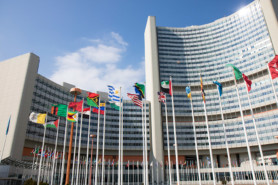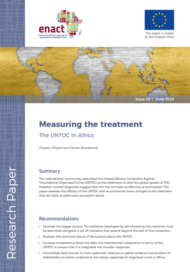Posted on 12 Mar 2019
Mexico’s Ambassador Alicia Buenrostro Massieu, former chair of the UN Commission on Narcotic Drugs, sets the tone for the next decade of drug policy at the UN.
On 14–15 March, the UN’s Commission on Narcotic Drugs (CND) will convene a ministerial segment on drug policy, the latest in a series of high-level meetings on drug policy over the last 10 years. This year marks the target of the 10-year plan to achieve the goals set out in the 2009 Plan of Action on International Cooperation towards an Integrated and Balanced Strategy to Counter the World Drug Problem. The 2016 UN General Assembly Special Session (UNGASS) on the world drug problem provided the most recent policy milestone, producing an outcome document that expanded the attention given to public health, development and human rights in drug policy. Although some criticized the UNGASS document as not going far enough in bringing new approaches to drug policy into the international framework, it opened avenues towards pluralism and individual states’ autonomy in their approach to drug policy (as has been discussed before through UNTOC Watch).
The debate among states continues to be where the focus of drug policy should be at the international level, particularly as countries are moving in different directions in their domestic policies. While ‘flexibility’ is the current buzzword, difficult issues – such as cannabis still being technically designated in the category of ‘most dangerous substances’, even as legal, regulated markets are becoming more widespread – are likely to surface. During 2018, Mexico’s Ambassador to Austria, H.E. Alicia Buenrostro Massieu, served as the CND chair and led the preparations for the upcoming high-level meeting. The Global Initiative spoke with her about her expectations for the upcoming session.
The ministerial segment is both a stocktaking of the past 10 years and a milestone for the next 10. What are your expectations for the upcoming ministerial segment?
The ministerial segment will be assessed more for the directives it dictates for future work than for the stocktaking that it may deliver of the past. The challenges, trends and patterns are ever evolving. At the same time, the biggest pending issue from the commitments set in the 2009 political declaration is the establishment of a solid system of data collection that would allow us to accurately assess progress made across policy commitments.
Following up on progress made on commitments adopted in 2009, 2014 and 2016 will shed more light on the positive impact that activities such as prevention, access to healthcare and to other social services, and providing economic opportunities have had on reducing the damage caused to people who use drugs – and to their families and communities. This wider approach has been dubbed a ‘single-track’ approach and seeks a more comprehensive reporting process than previously.
There is room for optimism because the development of a single-track data-collection system is at the core of ongoing negotiations, and there is broad support for the outcome document that is expected to be adopted during the ministerial segment. There is a recognition that limited and narrow-minded approaches to the challenges related to drugs are not working and that comprehensive, multidimensional ones are necessary. It is also recognized that member states cannot implement ‘police only’ policies, and that they also have to address social, economic, health and human-rights dimensions in policymaking around drugs.
How will developments over 2019 influence international approaches to drug trafficking and the political landscape around it?
The ministerial segment is an excellent opportunity to reflect on how much the world has changed since the current agenda for addressing the challenges related to drugs was created – and on how effective that model has been.
It will bring to light, as many commentators are pointing out, that the prevailing international consensus is shifting in terms of drug policy. More and more states are favouring a comprehensive and integrated policy response, instead of a limited one based on repression. But, it in my view, the core of the consensus is not changing, because all states continue to agree on the need to address the challenges related to drugs and counter the harmful impacts. No government supports drug abuse.
Needless to say, though, because realities in each region and country vastly differ, it is normal that priorities, strategies and tactics will vary as well. And new developments, such as an increasing prevalence of artisanal or home-made synthetic drugs and other hallucinogenic substances, including chemicals and salts, as well as online markets on the dark web, are changing the policy dynamics for states. These emerging patterns of drug production and trafficking will stress the current international drug-control regime, rather than one crafted with the realities of the last century in mind.
As this process will be the next step in drug policy since the 2016 UNGASS, what are the major areas of discussion among member states?
During the past decade, a number of commitments have been adopted. One major development in this process has been the acceptance by the CND membership that all commitments are complementary and mutually reinforcing. This concept may seem self-evident, but discussions have been hampered by a disagreement over whether the 2009 political declaration or the UNGASS 2016 outcome document is the primary drug policy document. So, we have taken a step forward in overcoming this circular discussion and this reinforces the value of the operational recommendations adopted at UNGASS 2016 as the filter by which the commitments adopted in 2009 and 2014 have to be implemented.
Yet, at the ministerial meeting we will witness, in all its clarity, the two differing approaches favoured by states: repression versus prevention.
What would you like to see happen in the next phase of drug policy at the UN?
The challenge in any field of policymaking is to strike the right balance between the general rules and the prevailing context. This is particularly true in the case of the drug policy control system. Rules, especially when they constitute the basis for an international regime, should not be changed frequently, responding only to specific contexts. But they also cannot be so detached from reality to become nothing more than a dead letter.
Technological innovation is bringing new challenges to the international drug control regime. Technology can provide powerful tools for prevention or countering the effects of the production, trafficking and consumption of drugs. But it also creates challenges. Technologies are impacting the way drugs are produced: today, almost anyone can produce home-made drugs using materials available in the market. And as an expert from the International Narcotics Control Board, responsible for monitoring designated illicit substances, said to me, we simply cannot include new substances in the lists as they appear on the market. It would seem that the current system is reaching its limits.
I would like to see the UN develop a mechanism for responding better and more swiftly to these kinds of new challenges. One key element will be better data collection and information analysis. As mentioned previously, the CND is at least moving in the right direction in this area by focusing on improving the capacities of states and the UN Office on Drugs and Crime in this regard. How we handle the flow of information is going to be the key.



